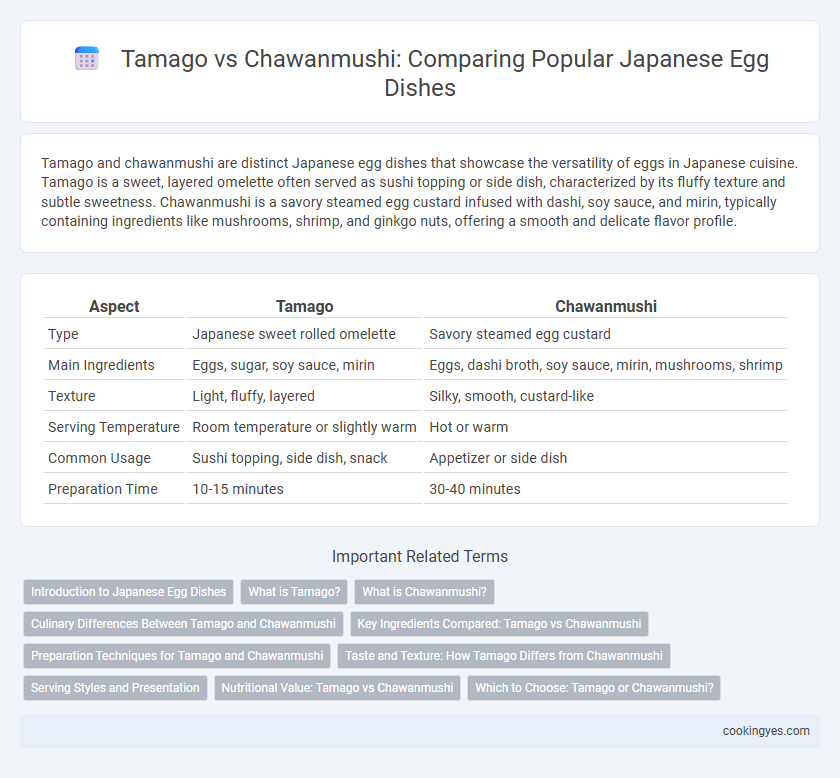Tamago and chawanmushi are distinct Japanese egg dishes that showcase the versatility of eggs in Japanese cuisine. Tamago is a sweet, layered omelette often served as sushi topping or side dish, characterized by its fluffy texture and subtle sweetness. Chawanmushi is a savory steamed egg custard infused with dashi, soy sauce, and mirin, typically containing ingredients like mushrooms, shrimp, and ginkgo nuts, offering a smooth and delicate flavor profile.
Table of Comparison
| Aspect | Tamago | Chawanmushi |
|---|---|---|
| Type | Japanese sweet rolled omelette | Savory steamed egg custard |
| Main Ingredients | Eggs, sugar, soy sauce, mirin | Eggs, dashi broth, soy sauce, mirin, mushrooms, shrimp |
| Texture | Light, fluffy, layered | Silky, smooth, custard-like |
| Serving Temperature | Room temperature or slightly warm | Hot or warm |
| Common Usage | Sushi topping, side dish, snack | Appetizer or side dish |
| Preparation Time | 10-15 minutes | 30-40 minutes |
Introduction to Japanese Egg Dishes
Tamago and Chawanmushi are iconic Japanese egg dishes showcasing distinct textures and preparation methods. Tamago is a sweet, layered omelette made by carefully rolling seasoned egg mixture in a special rectangular pan called a makiyakinabe. Chawanmushi is a savory steamed egg custard, incorporating dashi broth, soy sauce, and ingredients like mushrooms, shrimp, or chicken, offering a silky and delicate consistency.
What is Tamago?
Tamago, a traditional Japanese egg dish, consists of layered, slightly sweetened omelet made by rolling together several thin layers of seasoned egg mixture. It is commonly served as nigiri sushi topping or as a standalone dish, showcasing delicate texture and balanced flavors. The preparation emphasizes precise cooking techniques to achieve its signature fluffy and soft consistency.
What is Chawanmushi?
Chawanmushi is a traditional Japanese savory egg custard that is steamed to achieve a smooth, silky texture, often containing ingredients like shiitake mushrooms, kamaboko, shrimp, and ginkgo nuts. Unlike Tamago, which is a sweet, rolled omelette commonly enjoyed as sushi topping or side dish, Chawanmushi is served hot in a tea cup-like container and features a delicate umami flavor profile. This dish's unique preparation highlights the versatility of eggs in Japanese cuisine, emphasizing texture and subtle seasoning.
Culinary Differences Between Tamago and Chawanmushi
Tamago is a sweet, layered Japanese omelette made by rolling multiple thin layers of seasoned egg, emphasizing texture and slight sweetness, whereas Chawanmushi is a savory, silky steamed egg custard infused with dashi, soy sauce, and mirin, often containing ingredients like shrimp, mushrooms, and ginkgo nuts. The cooking technique for Tamago involves pan-frying on a rectangular tamagoyaki pan, creating a firm yet tender structure, while Chawanmushi requires gentle steaming to achieve its smooth, custard-like consistency. Tamago highlights a balance of sweet and umami flavors with a slightly firm bite, contrasting with Chawanmushi's delicate, savory profile and velvety mouthfeel.
Key Ingredients Compared: Tamago vs Chawanmushi
Tamago features a sweetened mixture of eggs, sugar, soy sauce, and mirin, creating a layered, slightly firm omelette with a distinctively sweet and savory flavor. Chawanmushi combines eggs with dashi stock, soy sauce, and mirin, often including ingredients like shiitake mushrooms, shrimp, and ginkgo nuts, resulting in a smooth, delicate steamed custard. The primary difference lies in tamago's emphasis on sweetness and layering versus chawanmushi's savory broth-infused, silky texture.
Preparation Techniques for Tamago and Chawanmushi
Tamago, a Japanese rolled omelette, requires precise layering and controlled heat to achieve its fluffy, slightly sweet texture through repeated cooking and folding of thin egg layers. Chawanmushi is a delicate steamed egg custard, where beaten eggs are combined with dashi broth and gently steamed at low temperatures to create a smooth, silky consistency with savory ingredients like shiitake mushrooms and shrimp suspended inside. The key difference in preparation techniques lies in Tamago's pan-frying method versus Chawanmushi's gentle steaming process, both demanding careful temperature control to preserve their distinct textures.
Taste and Texture: How Tamago Differs from Chawanmushi
Tamago features a sweet, layered, and firm texture achieved through expertly folded omelet layers, creating a slightly caramelized flavor profile unique to this Japanese egg dish. Chawanmushi offers a delicate, silky-smooth custard texture infused with savory dashi broth, producing a subtle umami taste that contrasts Tamago's sweetness. The distinct preparation methods result in Tamago's chewy bite versus Chawanmushi's melt-in-the-mouth softness, highlighting the diverse texture experiences in Japanese egg cuisine.
Serving Styles and Presentation
Tamago, a Japanese rolled omelette, is typically sliced into delicate, rectangular pieces and served neatly on sushi platters or as a standalone dish, showcasing its smooth, layered texture and slightly sweet flavor. Chawanmushi, a savory steamed egg custard, is presented in small lidded cups, highlighting its silky, creamy consistency often garnished with ingredients like shiitake mushrooms, shrimp, and ginkgo nuts for an elegant visual and taste contrast. The serving style of Tamago emphasizes firmness and structured layers, while Chawanmushi showcases softness and intricate ingredient incorporation through its custard form.
Nutritional Value: Tamago vs Chawanmushi
Tamago, a Japanese rolled omelet, is rich in protein and moderate in calories, offering essential amino acids and a source of vitamins such as B12 and D. Chawanmushi, a savory steamed egg custard, contains a higher moisture content and often includes ingredients like mushrooms, shrimp, and ginkgo nuts, enhancing its mineral and antioxidant profile while remaining low in fat. The nutritional difference lies in Tamago's denser protein concentration versus Chawanmushi's hydration and diverse nutrient infusion from added ingredients.
Which to Choose: Tamago or Chawanmushi?
Tamago, a sweet, layered Japanese omelette, offers a firm texture and subtle sweetness, making it ideal for sushi or standalone snacks. Chawanmushi is a savory steamed egg custard infused with dashi broth, soy sauce, and ingredients like shrimp or mushrooms, providing a delicate and smooth consistency. When choosing between Tamago and Chawanmushi, consider whether you prefer a sweet, portable dish or a warm, savory custard that highlights umami flavors.
Tamago vs Chawanmushi for Japanese Egg Dishes Infographic

 cookingyes.com
cookingyes.com